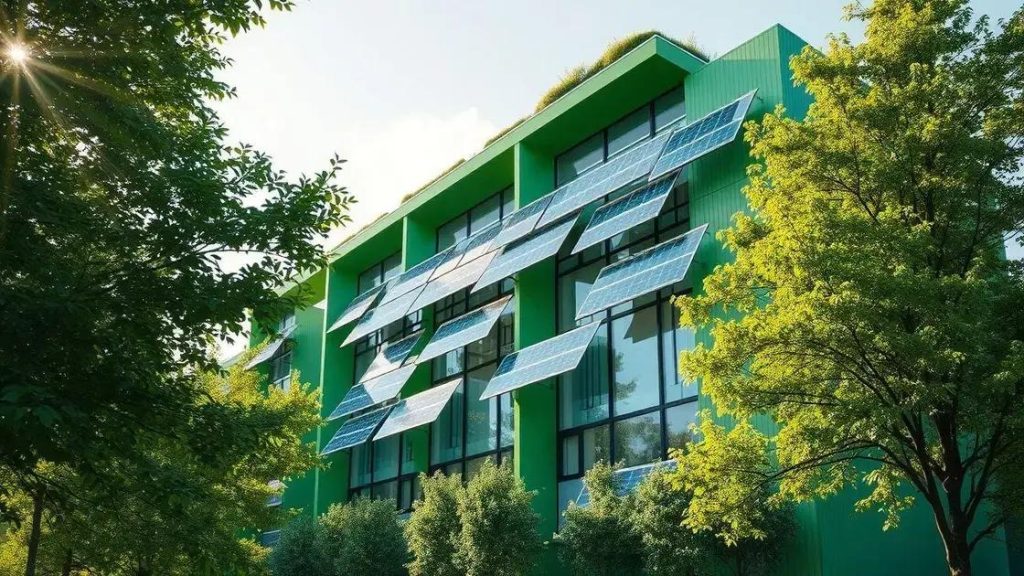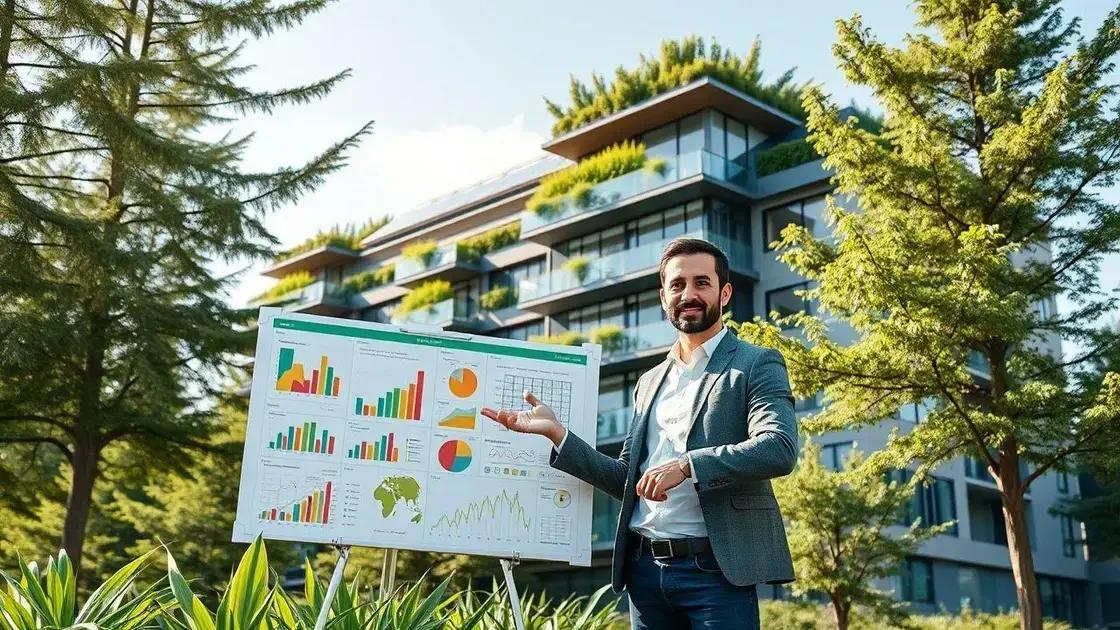Green investment tax credits for real estate developers

Green investment tax credits for real estate developers provide financial incentives for eco-friendly projects, helping to lower costs, increase property values, and support sustainable practices in construction.
Green investment tax credits for real estate developers present an exciting opportunity. Have you ever wondered how these incentives can transform your projects and boost profitability? Let’s uncover the details!
Understanding green investment tax credits
Understanding green investment tax credits is essential for real estate developers looking to invest in sustainable projects. These credits offer financial benefits while promoting environmentally friendly practices. Let’s dive deeper into what these credits are and how they work.
What are green investment tax credits?
Green investment tax credits encourage developers to engage in sustainable building and renovation. They include deductions and credits for implementing energy-efficient systems, using renewable resources, and improving existing structures to meet green standards.
- Encouragement of renewable energy use.
- Support for energy-efficient building materials.
- Financial incentives for eco-friendly renovations.
These incentives vary by location and can significantly reduce tax liabilities, making projects more financially viable. Understanding the eligibility criteria is crucial for maximizing these benefits.
How do these credits work?
Typically, these credits can be claimed on your federal income tax returns. The process involves submitting documentation that proves compliance with green standards. The credits are often based on the costs associated with upgrades, making it vital to keep thorough records.
It’s also important to stay updated with local regulations, as they can affect the amount of credit available. Sometimes, additional state or local incentives complement these federal credits, further helping developers.
Incorporating green technology not only qualifies developers for tax credits but also improves property value and attracts environmentally conscious buyers. As awareness of sustainability grows, so does the appeal of eco-friendly properties.
Benefits of green investment tax credits
- Reduced operating costs through energy efficiency.
- Increased marketability of properties.
- Long-term return on investment.
Overall, understanding these tax credits forms a crucial part of any successful property development strategy, blending financial prudence with a commitment to sustainability.
Benefits for real estate developers

The benefits for real estate developers from green investment tax credits are significant and multifaceted. These financial incentives can greatly enhance project feasibility while supporting sustainable practices. Understanding these advantages is key for developers aiming to make eco-friendly choices.
Financial savings
One of the most appealing benefits is the potential for financial savings. By taking advantage of green investment tax credits, developers can significantly reduce their overall costs. These credits offset expenses related to energy-efficient upgrades and sustainable practices.
- Lower upfront costs for renewable energy installations.
- Reduction in annual tax liabilities.
- Access to additional local grants and funding.
These savings allow developers to invest more into their projects, improving quality and sustainability while making them more attractive to buyers.
Market advantage
In today’s real estate market, having properties that meet green standards can set developers apart. A property that features eco-friendly designs is often more appealing to potential buyers or tenants, leading to higher demand. Many buyers prefer sustainable options due to their lower long-term operational costs.
Being recognized for eco-friendly practices can enhance a developer’s reputation, making it easier to secure future projects and investors. Properties backed by sustainable practices tend to sell faster and at higher prices.
Increased property value
Adopting sustainable methods not only qualifies projects for tax credits but also boosts property value. Eco-friendly features, such as energy-efficient appliances and renewable energy sources, can lead to higher appraisals and better resale opportunities.
Moreover, properties designed with sustainability in mind often experience lower vacancy rates and attract high-quality tenants. This leads to improved cash flow and long-term stability.
Community impact
- Promoting green initiatives in the community.
- Improving local ecosystems and reducing urban heat.
- Enhancing community health through better air quality.
Ultimately, the benefits of green investment tax credits extend beyond individual developers, fostering a more sustainable built environment that positively impacts communities.
How to apply for tax credits
Applying for tax credits can seem overwhelming, but it’s a straightforward process if you follow the right steps. By understanding how to apply, real estate developers can take full advantage of available incentives. Let’s explore the crucial steps needed to navigate this process successfully.
Gather necessary documentation
The first step involves collecting all required documents. You’ll need proof of expenses related to the green investments you’ve made. This includes invoices, contracts, and receipts for energy-efficient systems or sustainable materials.
- Invoices for solar panels or renewable energy systems.
- Contracts with energy efficiency consultants.
- Receipts for green building materials.
Having this documentation organized makes the application process smooth and efficient.
Understand eligibility criteria
Next, it’s vital to understand the eligibility criteria for the available tax credits. Different programs have specific requirements that must be met to qualify. Check with local or federal agencies for guidelines regarding what constitutes a qualifying project.
Pay attention to any deadlines for applications and the types of improvements that can be included.
Complete the application forms
Once you have your documents and understand the criteria, it’s time to fill out the application forms. Make sure to provide accurate and detailed information. This includes project descriptions, costs incurred, and the type of technology implemented. Some tax credits may require specific forms on federal or state levels.
After completing your forms, consider having a tax professional review them. This can ensure everything is correct before submission, minimizing delays.
Submit your application
- Follow the submission guidelines provided by your local tax authority.
- File the application forms along with the gathered documents.
- Keep copies of everything for your records.
Submitting your application on time is crucial, so make sure you are aware of any expected processing times, which can vary widely.
Understanding how to apply for green investment tax credits equips developers with the tools they need to benefit from these incentives. Each step is essential in ensuring that you can gain the financial benefits of these programs.
Case studies of successful projects

Examining case studies of successful projects offers valuable insights into how green investment tax credits can benefit real estate developers. These examples highlight strategies, innovations, and the tangible advantages gained through sustainable practices.
Residential Development in Austin
A recent residential project in Austin, Texas, successfully utilized green investment tax credits to implement solar panels and energy-efficient appliances. The project not only reduced energy costs significantly but also attracted eco-conscious buyers due to its sustainable features.
- 30% reduction in energy bills.
- Increased property value by 15% due to green features.
- Positive community response and lower sales time.
Developers noted that the financial incentives made investing in these upgrades much more feasible, ultimately enhancing the project’s overall appeal.
Mixed-Use Development in San Francisco
Another impressive case is a mixed-use development in San Francisco that integrated green roofs and extensive landscaping. By applying for tax credits, the developers were able to cover a significant portion of the costs associated with these features. The building saw a 40% increase in tenant engagement thanks to its beautiful environment.
This project illustrates the importance of aesthetics in sustainable design, where both residents and businesses benefit from enhanced visual appeal and improved air quality.
Commercial Building in New York
In New York City, a commercial building went under major renovations to include energy-efficient windows and HVAC systems. These upgrades were financed partially through green investment tax credits, showcasing how large-scale projects can also benefit.
- 20% decrease in overall energy consumption.
- Attracted premium tenants looking to reduce their carbon footprint.
- Improved employee productivity due to better workplace conditions.
These examples clearly demonstrate that understanding and utilizing green investment tax credits can lead to successful, innovative, and sustainable real estate projects. As the demand for eco-friendly solutions increases, developers who embrace these practices will likely see enhanced returns.
FAQ – Frequently Asked Questions about Green Investment Tax Credits for Real Estate Developers
What are green investment tax credits?
Green investment tax credits are financial incentives for developers who invest in energy-efficient and environmentally friendly upgrades in their real estate projects.
How can I apply for these tax credits?
To apply for green investment tax credits, gather necessary documentation, understand eligibility criteria, complete the required application forms, and submit them to the appropriate tax authority.
What benefits do these tax credits provide?
These tax credits can lower project costs, increase property values, enhance marketability, and promote sustainable practices in real estate development.
Can you give examples of successful projects using these credits?
Yes, there are many successful examples, including residential areas with solar panels and mixed-use developments featuring green roofs, both benefiting from tax incentives while enhancing community sustainability.





